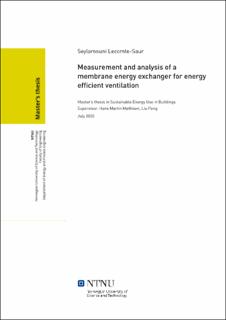| dc.contributor.advisor | Mathisen, Hans Martin | |
| dc.contributor.advisor | Liu, Peng | |
| dc.contributor.author | Lecomte-Saur, Seylamouni | |
| dc.date.accessioned | 2021-09-20T16:53:27Z | |
| dc.date.available | 2021-09-20T16:53:27Z | |
| dc.date.issued | 2020 | |
| dc.identifier | no.ntnu:inspera:57316911:34537743 | |
| dc.identifier.uri | https://hdl.handle.net/11250/2779663 | |
| dc.description.abstract | Energy recovery is an essential energy-saving measure for buildings with mechanical ventilation. In cold climate, a common issue with the widely used flat-plate heat exchanger is the condensation of moisture in exhaust air and formation of frost in the exchanger. The need for defrosting consumes energy and may intermittently reduce indoor air quality. A solution to reduce or eliminate frost formation is to use membrane energy exchangers (MEE), which can transfer water vapor as well as sensible heat between the exhaust and supply air streams. The use of membranes instead of impermeable plates creates a need for spacers in between the membranes, to support the thin membranes and avoid deformation of the air channels, which can undermine performances. The spacers influence the performances of the MEE: they can enhance heat and moisture transfer, resulting in higher effectiveness, but they also increase pressure drop, resulting in more energy consumed by the fans. Although many studies have been conducted to measure and predict the performances of MEEs in hot and humid climate, fewer have been conducted in cold climate, and very few have investigated the influence of different types of spacers. In this thesis, a literature study is presented on the latest developments of membrane energy exchanger technology. Experimental work has been conducted to measure the performances of a MEE with one type of spacer under different conditions of temperature, relative humidity and air flow rate. Then, a epsilon-NTU model was created using MATLAB, validated against the experimental data, and used to predict the performances of the MEE with different spacers, different geometries, and calculate the potential energy savings in different Norwegian cities: Trondheim, Bergen and Oslo. It was found that for the three cities the choice of spacer and geometry is of significant importance to maximise energy savings. Although there is a trade-off, as denser spacers both enhance heat and moisture transfer and increase pressure drop, it seems that pressure drop is predominant in limiting energy savings, especially when fan efficiencies are low. The orientation, corrugation size and corrugation shape of the spacers are factors that may contribute significantly to reducing or increasing the pressure drop, as well as the length and width of the exchanger. These factors will have to be investigated experimentally to confirm the results of this thesis. | |
| dc.description.abstract | Energy recovery is an essential energy-saving measure for buildings with mechanical ventilation. In cold climate, a common issue with the widely used flat-plate heat exchanger is the condensation of moisture in exhaust air and formation of frost in the exchanger. The need for defrosting consumes energy and may intermittently reduce indoor air quality. A solution to reduce or eliminate frost formation is to use membrane energy exchangers (MEE), which can transfer water vapor as well as sensible heat between the exhaust and supply air streams. The use of membranes instead of impermeable plates creates a need for spacers in between the membranes, to support the thin membranes and avoid deformation of the air channels, which can undermine performances. The spacers influence the performances of the MEE: they can enhance heat and moisture transfer, resulting in higher effectiveness, but they also increase pressure drop, resulting in more energy consumed by the fans. Although many studies have been conducted to measure and predict the performances of MEEs in hot and humid climate, fewer have been conducted in cold climate, and very few have investigated the influence of different types of spacers. In this thesis, a literature study is presented on the latest developments of membrane energy exchanger technology. Experimental work has been conducted to measure the performances of a MEE with one type of spacer under different conditions of temperature, relative humidity and air flow rate. Then, a epsilon-NTU model was created using MATLAB, validated against the experimental data, and used to predict the performances of the MEE with different spacers, different geometries, and calculate the potential energy savings in different Norwegian cities: Trondheim, Bergen and Oslo. It was found that for the three cities the choice of spacer and geometry is of significant importance to maximise energy savings. Although there is a trade-off, as denser spacers both enhance heat and moisture transfer and increase pressure drop, it seems that pressure drop is predominant in limiting energy savings, especially when fan efficiencies are low. The orientation, corrugation size and corrugation shape of the spacers are factors that may contribute significantly to reducing or increasing the pressure drop, as well as the length and width of the exchanger. These factors will have to be investigated experimentally to confirm the results of this thesis. | |
| dc.language | | |
| dc.publisher | NTNU | |
| dc.title | Measurement and analysis of a membrane energy exchanger for energy efficient ventilation | |
| dc.type | Master thesis | |
